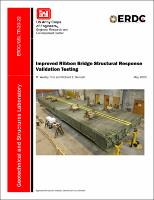Please use this identifier to cite or link to this item:
https://hdl.handle.net/11681/37113Full metadata record
| DC Field | Value | Language |
|---|---|---|
| dc.contributor.author | Trim, M. W. (Michael Wesley), 1981- | - |
| dc.contributor.author | Bennett, Richard E. | - |
| dc.date.accessioned | 2020-06-22T13:38:34Z | - |
| dc.date.available | 2020-06-22T13:38:34Z | - |
| dc.date.issued | 2020-05 | - |
| dc.identifier.govdoc | ERDC/GSL TR-20-22 | - |
| dc.identifier.uri | https://hdl.handle.net/11681/37113 | - |
| dc.identifier.uri | http://dx.doi.org/10.21079/11681/37113 | - |
| dc.description | Technical Report | - |
| dc.description.abstract | The Improved Ribbon Bridge (IRB) is a mobile, modular bridge system designed to provide wet-gap crossing capability to combat vehicles and trucks up to Military Load Capacity 96. The Bridge Supplemental Set (BSS) includes Bridge Erection Boats and an anchorage system to allow for the positioning and securing of the bridge in moving water. Designed to function as either a floating bridge or a raft, the IRB and BSS give military commanders multiple options with regards to the tactical river crossings. The US Army Engineer Research and Development Center (ERDC) was contracted by Product Manager Bridging to provide a structural analysis via high-fidelity numerical modeling of various IRB spans and water flow rates. To this end, a finite element model (FEM) of the IRB was constructed using field measurements of IRB interior bays. To ensure accurate structural response characteristics of the FEM and to build confidence in the simulation results, a validation test series was devised to generate empirical data to correlate against. This report documents the IRB structural response validation testing conducted at ERDC in March 2018. The data contained in this report was used to validate the IRB structural FEM. | en_US |
| dc.description.sponsorship | U.S. Army Product Manager Bridging. | en_US |
| dc.description.tableofcontents | Abstract .................................................................................................................................... ii Figures and Tables .................................................................................................................. iv Preface ..................................................................................................................................... vi 1 Introduction ...................................................................................................................... 1 1.1 Background ........................................................................................................ 1 1.2 Objective ............................................................................................................ 1 1.3 Approach ............................................................................................................ 1 2 Testing Methodology ....................................................................................................... 3 2.1 Pre-test preparations ......................................................................................... 5 2.2 Test setup ........................................................................................................... 6 2.2.1 One-bay configuration ................................................................................................. 6 2.2.2 Two-bay configuration ................................................................................................. 9 2.3 Instrumentation .............................................................................................. 12 2.3.1 One-bay configuration ............................................................................................... 13 2.3.2 Two-bay configuration ............................................................................................... 16 3 Summary: Test Results and Discussion ...................................................................... 19 3.1 One-bay test series ......................................................................................... 19 3.2 Two-bay test series ......................................................................................... 25 Appendix: Bay Data 2018-03-02 and 2018-03-07 ...................................................... 32 Unit Conversion Factors ....................................................................................................... 33 Acronyms and Abbreviations ............................................................................................... 34 Report Documentation Page | - |
| dc.format.extent | 43 pages / 5.38 MB | - |
| dc.format.medium | PDF/A | - |
| dc.language.iso | en_US | en_US |
| dc.publisher | Geotechnical and Structures Laboratory (U.S.) | en_US |
| dc.publisher | Engineer Research and Development Center (U.S.) | - |
| dc.relation.ispartofseries | Technical Report (Engineer Research and Development Center (U.S.)) ; no. ERDC/GSL TR-20-22 | - |
| dc.rights | Approved for Public Release; Distribution is Unlimited | - |
| dc.source | This Digital Resource was created in Microsoft Word and Adobe Acrobat | - |
| dc.subject | Matting | en_US |
| dc.subject | Military bridges | en_US |
| dc.subject | Stream crossing, Military | en_US |
| dc.subject | Structural analysis (Engineering) | en_US |
| dc.subject | Transportation, Military | en_US |
| dc.title | Improved Ribbon Bridge structural response validation testing | en_US |
| dc.type | Report | en_US |
| Appears in Collections: | Technical Report | |
Files in This Item:
| File | Description | Size | Format | |
|---|---|---|---|---|
| ERDC-GSL TR-20-22.pdf | 5.38 MB | Adobe PDF |  View/Open |